City Objects: The Evolution of Bike Share
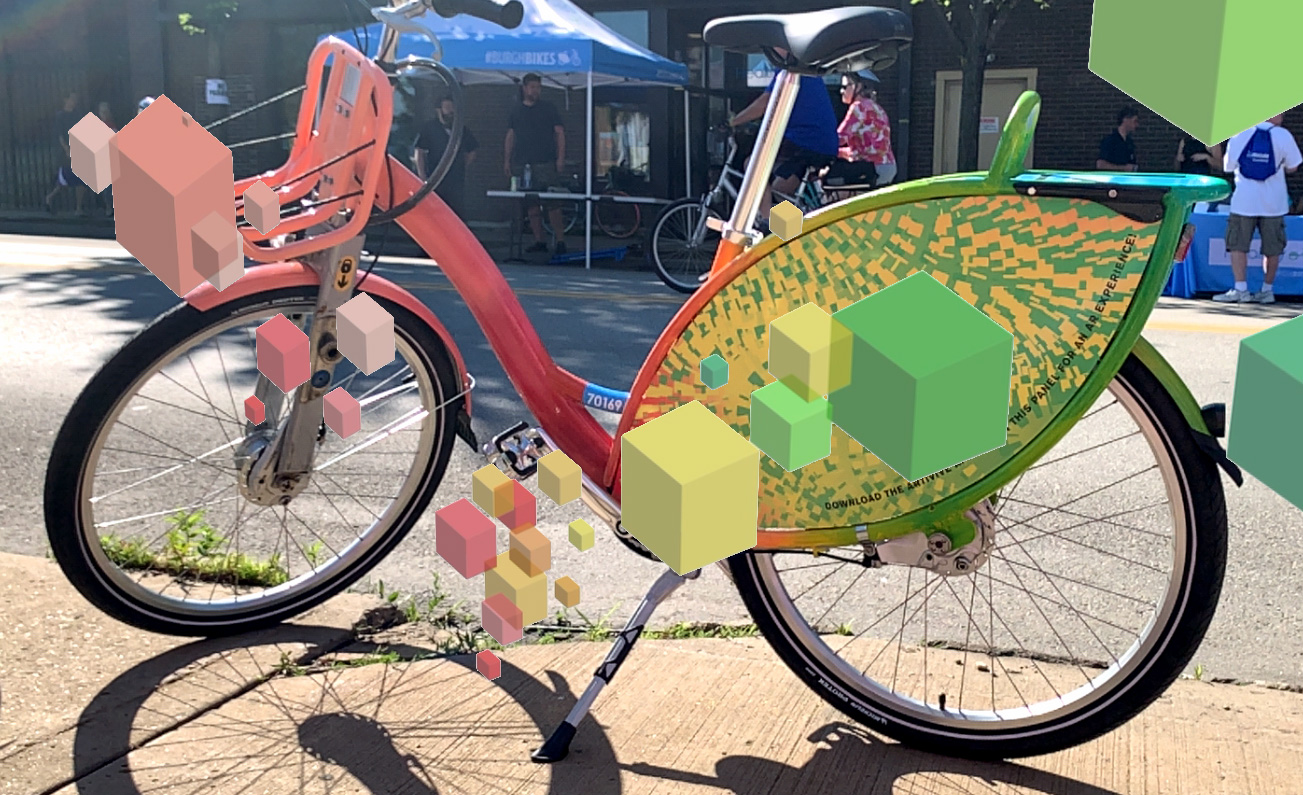



💭 Project Description
“Melancholy is incompatible with bicycling.” — James E. Starrs
The act of riding a bicycle is inextricably linked with human emotion. From the moment our foot first nudges the pedal forward, the journey is filled with reactions to the sights, sounds and smells around us that elicit a spectrum of emotion from intense fear to boundless joy.
DoUC’s augmented reality bike design is meant to express the range and fluctuation of feelings visually in both the physical and digital landscapes.
Our first iteration was a successful collaboration with Healthy Ride Pittsburgh’s 2019 Bike Art competition, where we transformed the physical bike with a colorful representation of the emotional gradient and combined it with a printed texture/pattern on the back panels to give the illusion of movement even when the bike is stationary.
Adding a new dimension to the experience, we used the back panel design as an augmented reality marker that would prompt riders (and the public) to bring the design to life with a dynamic digital experience that further visually expresses the extremities of fear, joy, and the moments in between.
With only a week in rotation, we have already garnered a 100 views of our digital experience.
We hope to build on this momentum by further engaging the narrative between a rider and the bike. We want to capture the feelings a rider experiences while biking as accurately as possible to effectively capture their journey and provide riders with a visual story-telling experience as a takeaway. To achieve this, we aim to leverage the geolocation capabilities that are often operating in the background of bike share systems and combine that data with the rider’s speed and heart-rate—using sensors added to the bikes themselves—to determine a range of emotions the rider experienced along the journey and generate an augmented reality data-visualization in real-time. Our goal is to transform an often repetitive or fleeting experience into something meaningful. Something to remember, retrace, and even revisit— an augmented reality archive of the tangible and intangible moments of a ride.
The flexibility of our concept allows us to potentially extend our design to any bike, even to those featuring custom bike art like Healthy Ride’s unicorn bikes. By using unique AR markers for each design that digitally animates the artists’ work, we can display a moving version of the bike art that also oscillates to convey changing emotions. Essentially generating living artwork that is transformed by each unique ride.
The project team included: Christopher Pandolfi, Heather Mallak, Melanie Kapogines, and Shaili Chibba.
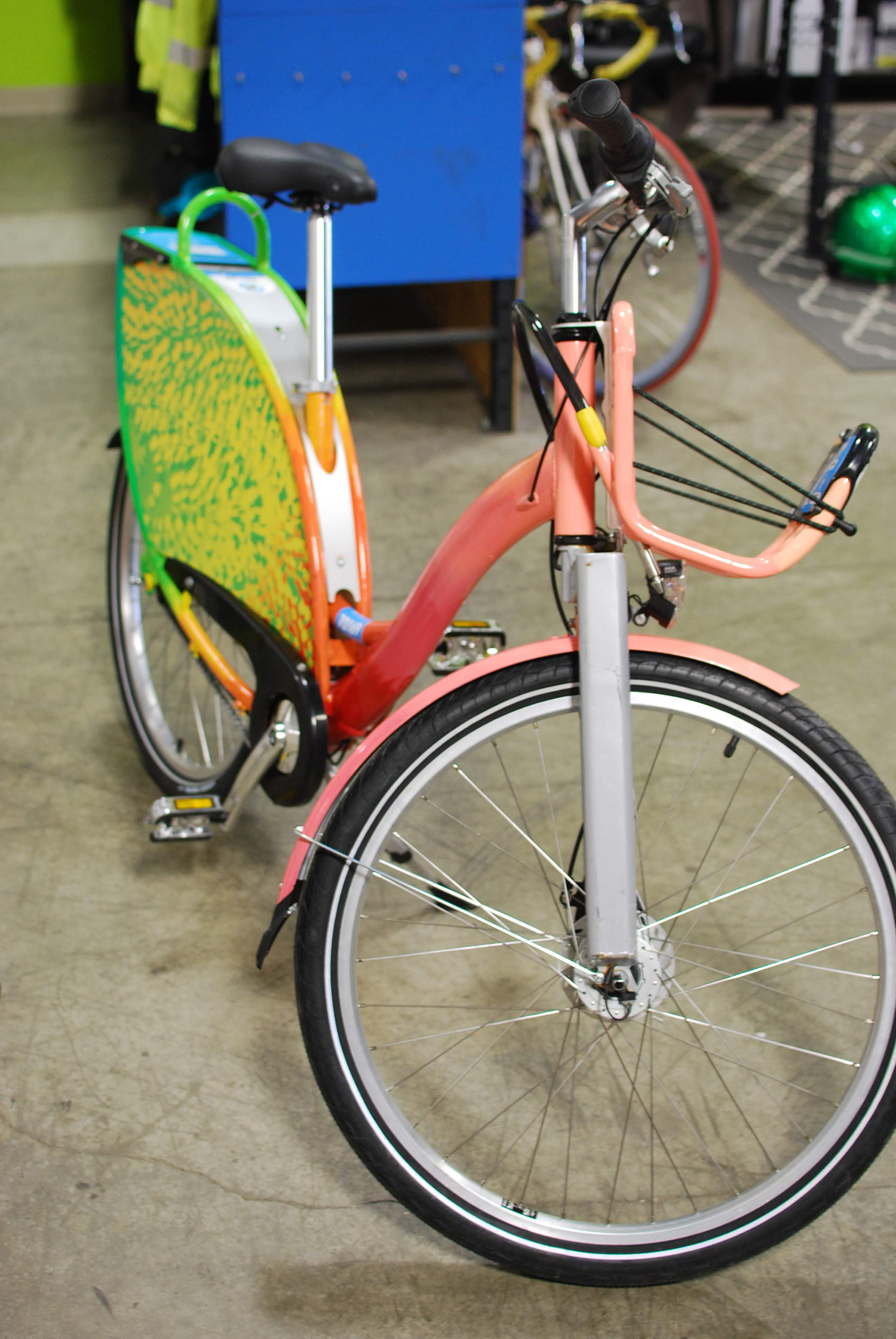
The final, freshly painted bike!
Heather also invited us to do an XR MediaLab class with a group of kids at Sarah Heinz House, a long standing Boys & Girls Club— here’s Mel showcasing the work:


To commemorate DoUC’s 10 year anniversary, we have organized an interview series highlighting past DoUC projects.
We wanted to take this milestone opportunity to revisit projects in a fun and reflective way, calling on the perspectives of both past and present DoUC team members. Shifting from objective and brief project descriptions, we revisited our work with a renewed intimacy. With more personality. We hope this series provides deeper insight and understanding to past projects. Or, is simply a fun read!
To help you navigate this series, we recommend first reading the project summary for context. Then, you can explore the interview dialogue. Enjoy! 🙃
ℹ️ The City Objects: The Evolution of Bike Share interview was conducted with Chris Pandolfi (CP), Heather Mallak (HM), Mel Kapogines (MK), and Shaili Chibba (SC).
In your understanding, what was the initial goal of the project? What were you attempting to address?
CP ⤳ The initial goal of the project was to experiment with the concept with how we could think about the human emotions and how they could influence the design of a larger system, more specifically how could we create a situation in where users could actively be involved in the redesign of the system.
MK ⤳ Honestly, when I initially suggested we look at the competition, it was mostly to give us something quick and fun to think about on a Friday afternoon. I secretly had it in my head that it might be a great opportunity to do something with AR but kept it to myself to see where everyone else’s heads went while we were brainstorming ideas. It ended up being a great extension of the City of Experiences thinking, connecting back to how the physical and digital systems in the city are connected to our emotions.
SC ⤳ The project is a part of the City of Experiences umbrella, and when we started this we really wanted to experiment with taking that concept further— to explore City Objects. So, this is one of our explorations around the kinds of things that could facilitate the experiences within a city.
HM ⤳ Participation in a artist edition public bike initiative. Gradient paint colored rentable bike that framed an AR panel that represented the range of emotions experienced while riding.

The final bike + AR overlay.
What was your role in this project? How did you approach it?
CP ⤳ Creative Direction. I approached the project as an exploration. The idea that we were not trying to look for anything specific but instead explore and see where that exploration ended up.
MK ⤳ I brought the contest up as something we could do, worked to refine the proposal, and then mainly kept things coordinated between Toronto and Pittsburgh. I’ve also done most of the writing for the project after we finished making the bike.
SC ⤳ I was a designer in this project, and in terms of my approach… I simply tried my best to translate and communicate our main concept in the designs. It was fun trying to capture that emotional gradient in an abstract way through both the 2D and AR-3D visuals.
HM ⤳ I was tapped for helping to paint the bike as DoUC members were out of town when the day was deemed for the group paint. I’m more fluent in AR but had been a very active painter for decades.
The DoUC AR Bike was part of a larger festival (Healthy Ride Pittsburgh), how did the studio get involved?
CP ⤳ Mel, DoUC Managing Director lives in Pittsburgh and came about the competition through her network
MK ⤳ (Side note: Healthy Ride is actually the name of the bike share program in Pittsburgh, not a festival….the festival was Open Streets, where they shut down a major route to car traffic one day each month in the summer 🙂
Healthy Ride is always a big part of Open Streets because they’re one of the main bike organizations/advocates in Pittsburgh (alongside Bike PGH) and they used the event to launch the ArtBikes into the fleet for the summer. They invited us and the other artists to participate and show off the bikes before they set them free 🙂
SC ⤳ The credit here goes to Mel! Who is a super cool resident of Pittsburgh and our CEO-extraordinaire 🙂
HM ⤳ Mel identified the opportunity in Pittsburgh and brought it to the International team. DoUC submitted a proposal and used this opportunity to roll out their concept of a prototype for a more complex sensor / output public facing concept.
The AR Bike is also a part of a larger family of projects: the City of Experience. Can you tell us more about how this project fits into it?
CP ⤳ This project fits into City of Experiences by being an idea that has come directly from the studio. What I mean by this is that City of Experiences as it was originally conceived was to get many different types of stakeholders involved in designing the city with a blended understanding of the digital and physical world. It is more a process than a specific project, offering the potential for a multiplicity of different outcomes. Where this project was a specific idea, explored, experimented and created by DoUC. This also gave birth to a subset of research know as city objects. The idea behind city objects is exploring how an existing physical object can be transformed by a digital layer without ever losing its existing function and core experiences. More importantly it also takes into consideration the ways that a user can feel comfortable and understand how they give consent to a series of digital layers that add to the experience, but maybe are not crucial to the objects intended use.
MK ⤳ City of Experiences is focused on getting people to think differently about how we build cities and the experiences we want to have in them, starting with emotions and feelings first and building towards the experiences based on that, rather than the other way around (building something physical and then deciding what kind of experiences you can have in that already-designed space).
The bike was a prototype for taking that thinking further, how we can create objects in the city that have very mundane, everyday uses and layer experiences on top of them that are designed from the emotions we want to have in the city. The idea is to be able to create these added layers of experience without changing the normal use of the object—you can still use the bike as just a simple bike if you choose, but there’s the option of this elevated digital experience if you want to opt-in.
SC ⤳ This project is an exploration of City Objects— things that marry the physical with the digital to create enhanced micro-experiences within a city.
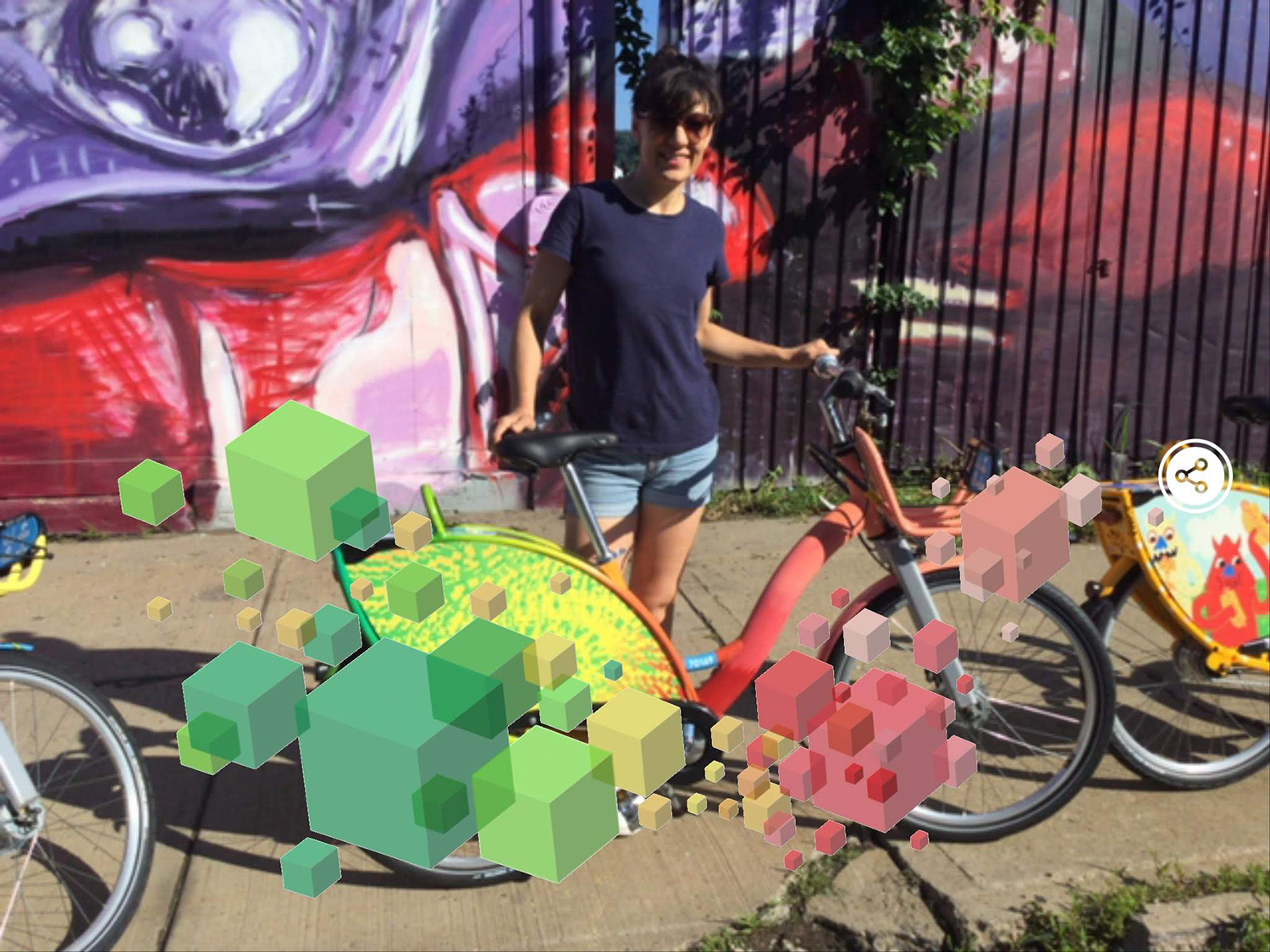
Mel at the launch of Healthy Ride Pittsburgh’s Art Bikes event with our final bike.
How do you feel this project transformed the, often repetitive, experience of cycling into something more meaningful?
CP ⤳ First I think cycling is amazing and I do not think we improved the amazing act of cycling. What I think we did try to improve was the safety of the cycling system and found different ways for cyclists to communicate and to influence the overall design of the system and also to think about ways they could non verbally share their emotions with other individuals using our Right of Ways (aka streets :))
MK ⤳ The bike itself just looked super beautiful (Heather killed it with the painting!), but the concept for the bike was meant to extend beyond the actual ride in a couple of ways. We talked about the possibility of the rider being able to track their emotions during the ride (or across many rides) through visualizations and also having some form of those visualizations being expressed through the AR component in real-time, so that people around them (future people where everyone has AR wearables on all the time) would see the virtual content as taking up extra space around the rider and keep more distance between them, providing some amount of added safety from drivers.
Second, there’s the possibility of the data collected helping to inform safety on the streets. If there’s an intersection or stretch of road where every riders heart rate increases dramatically and their palms sweat, there’s a good chance it’s because they feel fearful and the city could use that information to make targeted infrastructure changes.
SC ⤳ I’m not one to personally use cycling as a mode of transportation, simply because Toronto doesn’t quite support a safe system consistently throughout it’s regions, but I imagine for folks who do so regularly it would be a fun way to passively collect experiential data and experience it in a unique way. More of a visual story than a bunch of data visualizations graphs/charts.
HM ⤳ The visuals were standalone beautiful sans the interactive. DoUC injected thoughtfulness and innovation into an already novel concept of customizing a few bikes in a sea of bland branded ones.
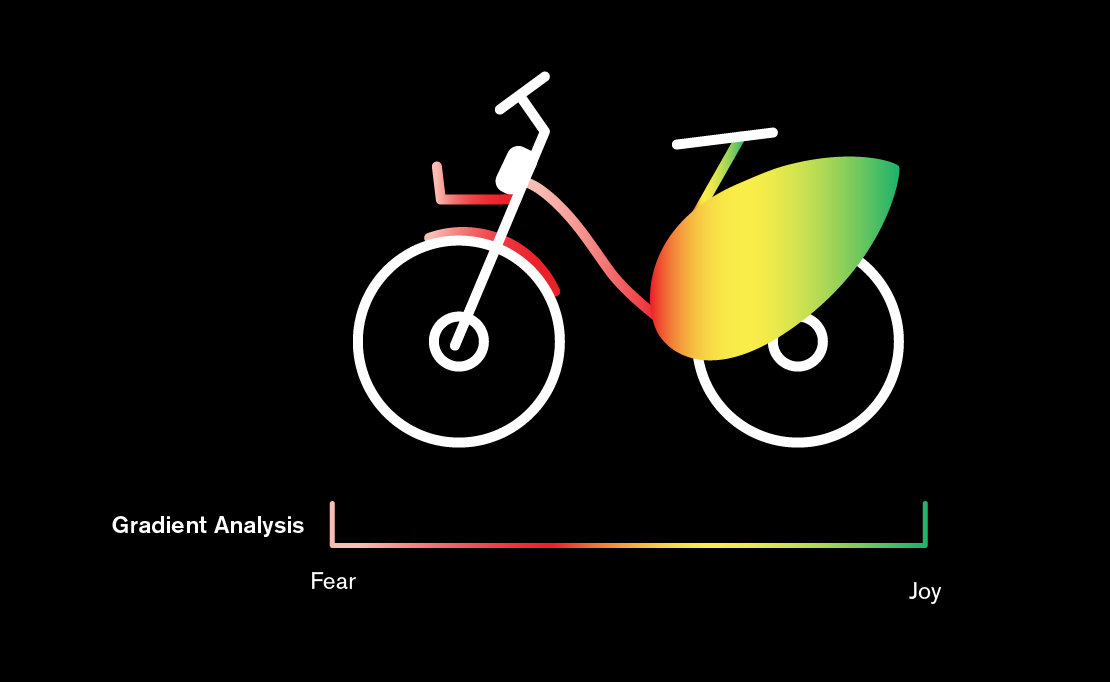
The NSA gradients came into play again perfectly— this time showcasing some fear for the rider at the head of the bike slowly transitioning to joy at the back.
Why did you choose joy and fear to be the extremities of the emotional gradient?
CP ⤳ I think this was a choice based on my own personal experiences in a bicycle and from what I had heard from other people when we talk about riding bikes.
SC ⤳ While ideating, we felt that this was a pretty good range of emotions experienced while cycling and a simple place to start our exploration.
HM ⤳ I agreed and have certainly experienced them too
If you bike, do you feel as if you experience a range between joy and fear?
CP ⤳ All the time…Every time I am on my bike. Which is a lot
MK ⤳ Absolutely! Sometimes you still get that feeling of pure joy you had when you were a kid. For me it always seems to be on warm summer evenings, takes me back to biking home from a friend’s house and that feeling of summer vacation being endless.
Fear is usually because of safety, cars too close or coming up behind you too fast, drivers getting ragey at bikers, or biking alone at night.
SC ⤳ Only leisurely, and it’s mostly joy with a dash of annoyance and fear when folks don’t understand trail rules.
HM ⤳ ya. depends on environment but yes.

Heather Mallak, our fantastic painter! Also an all-around fantastic artist.
On a slightly side note, name some other emotions that you’ve experienced during your journeys… without context. Haha!
CP ⤳ Well I think I always do my best to feel a sense of curiosity. Sometimes better tan others 🙂
MK ⤳ Giddiness, impatience, pain, discomfort, anxiety, freedom, refreshment, competitiveness, uncertainty,
SC ⤳ Calm, confidence, delight, frustration, exhaustion, annoyance, curiousity, motivation…
HM ⤳ weightlessness, windswept, urgent, relaxed, elated, calm, current, bored in a good way
You mentioned in your project description that for future iterations the studio aims to leverage smart sensors like geolocation, speed, heart-rate, and more for determining a range of emotions which the rider experiences during their journey— can you explain why you’ve chosen these parameters to inform us about the riders emotions?
CP ⤳ I think first and foremost because they are very typical and easy to implement sensors in a variety of ways on the bicycle themselves. This is important because the user has the control of whether or not they want the sensors to read or share their data. When we were designing the conceptual system for the Bike we needed to make sure that we data we were collecting was relevant to the decisions that could be analyzed but also what were sensors that were easy to implement and also have a track record of actually working. These types of sensors have been in use for quite sometime. We just wanted to bring them together in a different ways.
SC ⤳ It’s a start, but we think that location, speed, and heart-rate are at the core of a cycling journey. Where did you start? Where did you pause? Where did you end up? How fast did you go? How slow did you go? How often did this speed change? How did this affect your heart rate? Then, when you start intersecting the categories and questions, you really get into the heart of the layered experience.
What kind of potential do you imagine using cyclist data has to better inform a city’s infrastructure and provide a safer experience for urban cyclists?
CP ⤳ I think first and foremost it can help us better understand the routes people take and direct attention to how people feel on those routes to better understand the types of improvements that may need to be made to biking infrastructure. I think the key thing to understand is that at the core of the data is the idea of how people are feeling and create systems change based on people feelings as a driver for evidence based data.
MK ⤳ If you can understand how people are feeling throughout an experience exactly in the moment and without even having to ask them, there’s a lot of opportunity to find the real places the system breaks down.
SC ⤳ I think it would answer these fundamental questions: Where do cyclists experience joy + why? Where do cyclists experience fear + why? And, we can simply improve the spaces of fear into spaces of joy.
“The competition ensured that we had the room to explore and could set our own rules. We used a really simple process where we gave ourselves a morning to come up with the idea and create the necessary assets to communicate it.“
Please tell us more about the design process! The project description helps give some background information on the physical design of the bike— but, we’d like to know why you chose these colours to represent the emotional gradient of joy<->fear?
CP ⤳ Process was really fun. We treated this as an exploration and experiment. The competition ensured that we had the room to explore and could set our own rules. We used a really simple process where we gave ourselves a morning to come up with the idea and create the necessary assets to communicate it. It’s funny because this process was also similar to how we developed the AR clock. We used the city of experience research as a bit of a guide. If I recall we did a condensed version of a question exercise we do at the studio called 1 000 000 000 questions and with this small process were able to come up with the idea for the bike. Which fortunately we were a finalist.
MK ⤳ I think this was Chris sneaking in the NSA again….?
SC ⤳ These colours initially came from another exploration previously done by the studio— one that had a range of gradients in it, but we felt that this one best captured what we wanted to communicate. Really, if you look at fundamental human understanding of colour, often best represented by simply functional experiences in our lives, you will find one example: a traffic light. Go is green, red is stop. Go = moving with joy, red = stopping with fear. If you really want to get into the nitty-gritty of it, green = life in nature, red = wound/blood in nature. They’re really just the most direct and fundamental colour representations of what we were exploring, and we chose to keep it clear while layering on the fun and aesthetics.
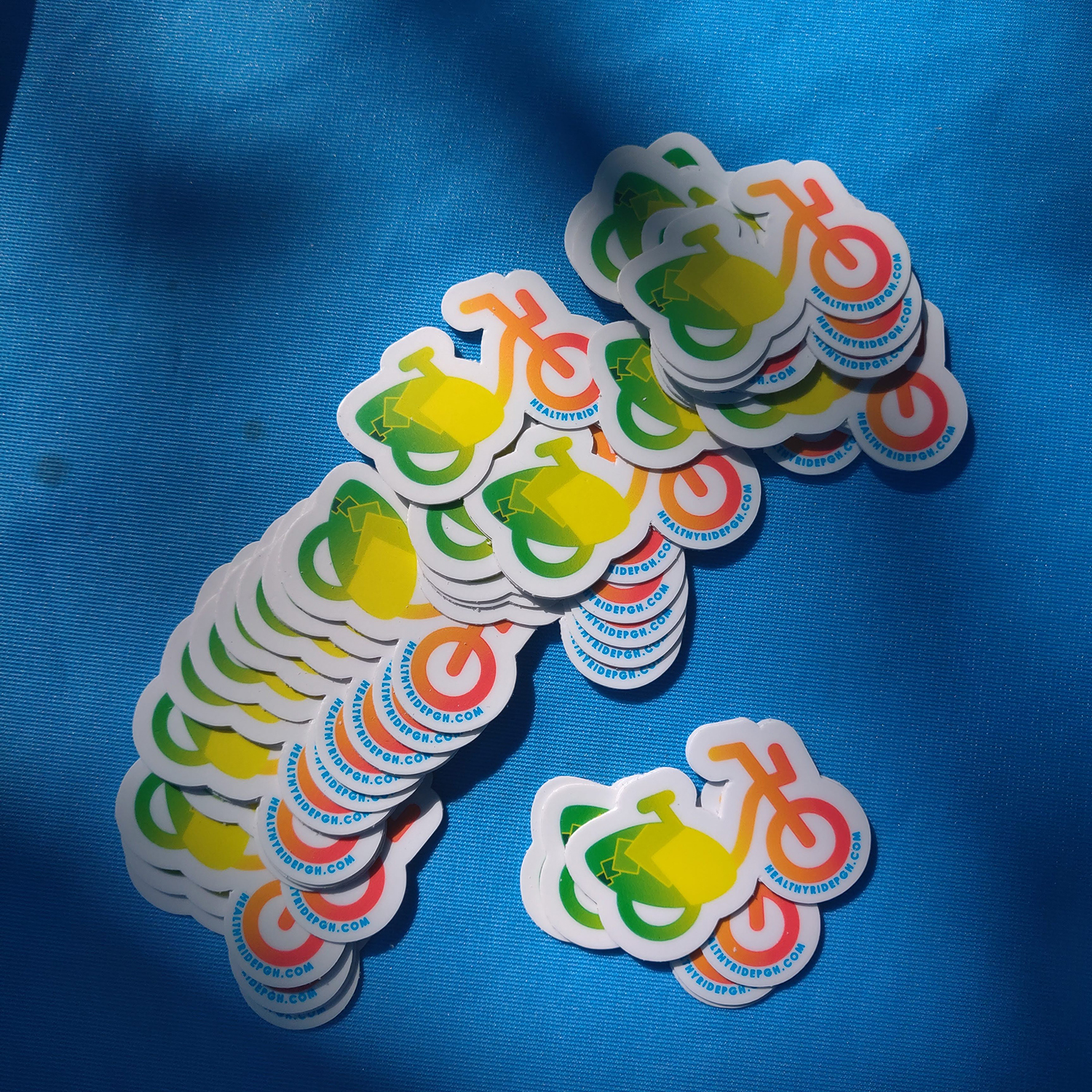
Isn’t the simplified bike design on the Healthy Ride stickers just adorable? 🥺👉👈
What inspired the abstract design on the panels? Does it have any meaning/connection to the emotions in the gradient?
CP ⤳ LOL…In terms of colours see NSA gradients…The panels I think were trying to allude to the experience we were trying to convey and also had to be readable as AR marker which influenced how it would be designed.
SC ⤳ It definitely does! We were initially exploring different kinds of 2D shape patterns and illusions that would mimic the fluidity of motion even when the bike is stopped, and we decided to sort of meld those explorations with a more abstract approach to capture the feelings.
“I pulled out painting skills to step up to the challenge. So I have never worked with One Shot enamel before. Luckily when I was tasked with the paint job I was at the apple store with my son’s school. Three doors down was a high ends art store.“
What was it like painting the physical bike? How did you achieve the gradient so smoothly?
CP ⤳ We had a really great artist do it!
MK ⤳ Heather said it was hell lol. I don’t know how she did such an amazing job, other than she’s persistent and a perfectionist.
HM ⤳ I pulled out painting skills to step up to the challenge. So I have never worked with One Shot enamel before. Luckily when I was tasked with the paint job I was at the apple store with my son’s school. Three doors down was a high ends art store. To the clerk, I described the medium and material it was being applied to. They directed to the specialty brushes. I thought I could at least go armed with quality brushes on my side. Healthy Bike coordinated with PPG Paints and all artist had the day at the facility to access their One Shot pain supply. So I attend the day with a digital gradient mock-up and brushes in hand with half a dozen other active artists. I relied on my past experiences to achieve creating the color and blend that came close to the digital mock-up. With doubt but hope I manipulated the enamel on the bikes. Encouraged by fellow artists, I completed the task to a point I was pleased at achieving the desired outcome.
Are there any other features you would have liked to add to the physical bike design if you could have? Not for data purposes, but for the visual concept or even just aesthetics.
CP ⤳ None
SC ⤳ It would’ve been super fun if we could paint the ENTIRE bike structure, frame + seat + handles + basket + etc all with the gradient to really capture the full story.
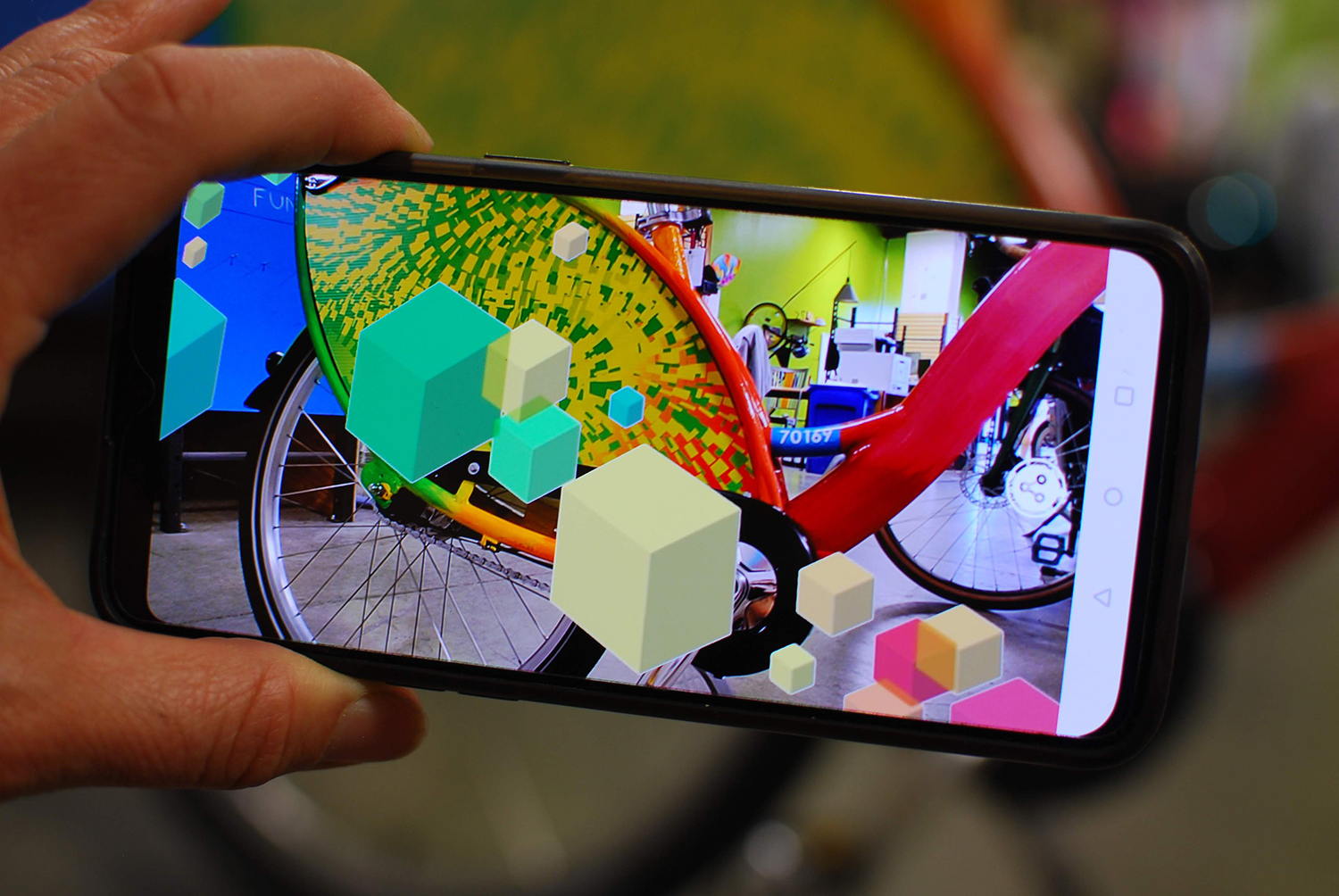
You’re currently looking at a screen, looking at a screen, looking at our AR design 🤓😎
Tell us about the AR experience. Why was it important to choose this medium as the method of communicating the user’s data?
CP ⤳ We felt that AR would be an interesting solution as we considered a near future scenario where everyone would be free from their smart phones to access AR and live in a world with contacts or some sort of glasses. This would allow people to better engage with the experience and system we were trying to create. What we created for the Bike was exactly what we felt it was – a prototype. Using the tools we had available to us to create a simulation in the real world of the possible future world the project would live in. In regards to the users data we felt it would work best because it could exist as interesting layer that could become part of the city.
MK ⤳ In addition to the possibility of creating virtual safe spaces for bikers mentioned above, it also ties into this City Objects idea of creating a new experience without necessarily altering the original experience. Other than the bike being different colours than the rest of the fleet, if you rent that bike it can be exactly the same as any other bike. Using AR allowed us to layer on the visual experience in a way that people could opt-in or just use the bike normally.
SC ⤳ This might sound sappy, but I think it was because it’s a layer on our physical experience… just like our emotions are. It adds to whatever is already there in a new and interesting way!
How did you go about making the AR experience for the current design? What were you unable to incorporate and would like to have in the future iterations?
CP ⤳ We used a simple AR tool called Artivive. It allowed us to create our own visuals and simulations and easily upload it to a platform that would be accessible to many different types of users. For this first iteration of the bike it was a perfect tool. I think the next phase would be to develop a real time app that we would build ourselves and connect to the system.
SC ⤳ This was a fairly simple iteration, because it’s not using live data. So, in the future, we’d love to incorporate live data from the actual ride using the sensors previously mentioned and truly visualize the unique story for each journey.
Why did you choose the back panels as the AR markers?
CP ⤳ For this iteration it made the most sense, especially from a usability point of view.
SC ⤳ Simply: they were the space given to us by the competition to design in 🙂
Currently the AR experience for the bike shows as cubes mimicking the journey of the rider and the emotional gradient— spitball some ideas on how you would show the future smart sensor data! We challenge you to make it just as aesthetically appealing while doing this if you can.
CP ⤳ would explore more of a kind of heat map idea that would encompass a kind of bubble around the user. The data would be in constant motion …
SC ⤳ It would be super fun to incorporate different shapes, and maybe the shapes themselves also layer on a third-level of meaning with colour and emotion. Also, it would be fun if these shapes could be instead laid around the bike parallel to the ground creating a map of the journey! And lots more, but maybe I’ll keep those ideas to myself so we can make them and surprise you all in the future.
HM ⤳ Softer looking “bumpers” or more aggressive spike designs.
Were there any obstacles, challenges, or difficulties that you experienced while designing or building the prototype? How did you navigate them? What kind of effect did these challenges have on the final result?
CP ⤳ I think the biggest challenge would have been to find someone to paint. Luckily Mel had contacts to make this happen.
MK ⤳ We were in Copenhagen on the day Healthy Ride scheduled to paint all the bikes, and luckily a mutual friend connected us with Heather and she saved the day. She did a great job on the bike but she’s become a great partner as well, we’re hoping to collaborate on other projects in the future.
We also had trouble finding somewhere free to host the AR content, platforms seemed to be disappearing which is really disappointing.
SC ⤳ We really wanted to do as much as we could with the AR data, but for a small proposal it would’ve been far too much work and time taken up, so we compromised with an AR animation that got our idea across. It still looked quite nice, but it’s not everything we’d want it to be.
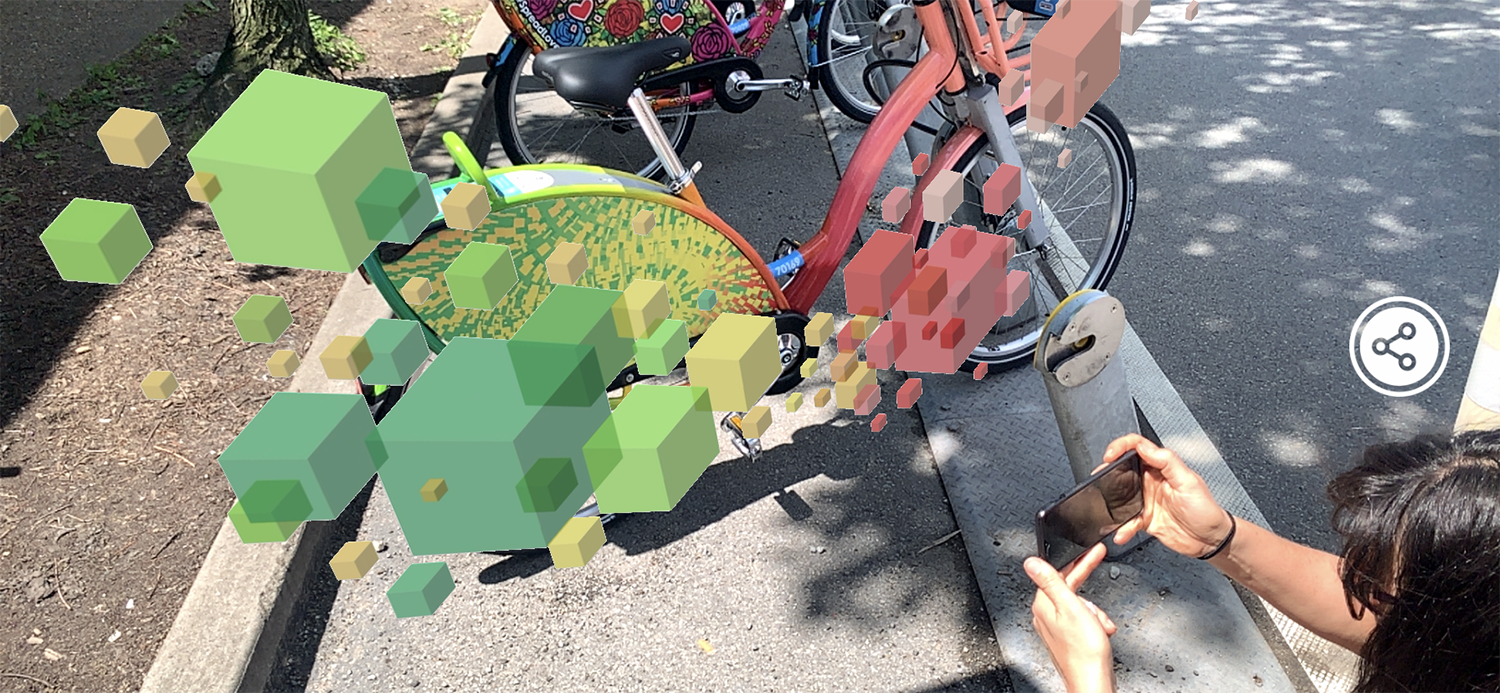
Mel and friends testing out the AR experience during the Healthy Ride Pittsburgh Art Bikes launch.
When designing the bike, did you have any hopes for how users would interact with it? How did users’ reactions to the final prototype mirror those expectations (if any)? Or, how did they differ? Was there anything that surprised you?
CP ⤳ I think because I was not there I missed out on this and did not really get to see the reactions
SC ⤳ We really hoped that people would ride the bike, try out the AR, and get curious about their own emotions as they reflect on their journeys. In whatever order!
“Last we heard it had been pulled in for the season early in late 2019 thanks to someone attempting to steal it 🙁“
Where is the bike at now? Is it still being used around the city of Pittsburgh?
CP ⤳ LOL I have no idea…should probably check in
MK ⤳ Last we heard it had been pulled in for the season early in late 2019 thanks to someone attempting to steal it 🙁 Art thieves maybe? I’ve lost track of where it is now because of the pandemic and not being in Pittsburgh for 7 months, I’m not sure if it’s back on the streets but it was supposed to be!
SC ⤳ In Pittsburgh, hopefully still being used! I did hear that it suffered some damage though, but hopefully it’s back up and… cycling.
If you were to continue with this project now, how would you picture that happening? Would you be interested in launching a similar project in your city?
CP ⤳ I think the next phase is to approach a city and really prototype the project out. I think we could make this project anywhere.
MK ⤳ The recent Smart City proposal we were working on made us think about the bike again, that we should be pushing it elsewhere. I think we’d all love to figure out a way to either launch more of the AR enabled bikes as part of a city bikes program, even if it’s just for the novelty of the artwork experiences you could share through AR. But what would be really great is to find someone willing to foot the bill to explore what the next prototype could look like, starting to incorporate the sensors and potential for data.
SC ⤳ It would be super fun if Toronto did this. We have so many bike rentals!
What are some lessons that you take away from this project and it’s process?
CP ⤳ (1) Sometimes the simple ideas are the best. (2) Sometimes the simplest processes are the best. (3) Taking time to experiment is always worth it— the most important part.
MK ⤳ You never know when you might win.
SC ⤳ This project was super fun and explorative, and I hope to bring these kinds of emotions to other projects as well.
